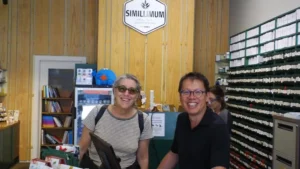
As you might expect, homeopaths are busy trying to understand how to heal COVID-19 and to come up with a set of genus epidemicus remedies — the ones most likely to successfully treat the various stages of the disease. As more and more people become ill, more folks are contacting homeopaths. And as things progress, I will be especially interested in hearing from India, since homeopathy is a mainstream form of medicine there, with thousands of working homeopaths functioning as full-fledged doctors.
Recently, homeopath Jeremy Sherr, who (along with his wife Camilla) leads the amazing group of homeopaths in Tanzania treating AIDS and other ailments, spearheaded the creation of a database to collect and analyze COVID-19 remedy and treatment information. The preliminary results point to the following top remedies: Phosphorus, Antimonium Tartaricum, Bryonia, Gelsemium, Phosphoric-Acid, and Arsenicum Album (with Antimonium Tartaricum being Jeremy’s favorite).
Of course, Bryonia and Gelsemium are important plant remedies for treating the flu. However, I am struck by the fact that the other mineral-based remedies are all made from elements in the same column of the periodic table: phosphorus, arsenic, and antimony. In fact, another useful remedy for COVID-19 is the more obscure remedy Antimonium Arsenicosum — made from a combination of antimony and arsenic.
Some of you may be familiar with the work of the brilliant Dutch homeopath, Jan Scholten. Using existing proving information for remedies made from the elements, he came up with what has turned out to be an incredibly powerful theory about the inherent meaning and nature of these remedies. Using this theory, homeopaths have even been successful in treating patients utilizing remedies made from heretofore unproven elements.
As Scholten discovered, remedies made from elements in the same row or column tend to have a theme to their symptomatology — physically, emotionally, and mentally. The rows have themes, starting from the top, of Being, Identity, Relationship, Work, Ideas and Creativity, Power, and Spiritual Power. In contrast, the columns have themes that begin (on the left) with slowly building confidence and mastership, to complete mastery (the center column), and then slowly losing that control and mastery until there is release. By combining this information together, a theme for a particular element can be derived. For example, the element at the center of the “Work” row would have a theme of obvious mastery over work.
Given this information, Scholten posits that the progression of elements through the periodic table mirrors our evolution as human beings — from finding out who we are, to attaining mastery over the various aspects of life. And in order to spiral upward, we also need to be able to, at times, let go of a particular theme and move on.
Now as I said, all of the COVID-19 mineral remedies are made from elements in the same column, to which Scholten has attached the theme: LOSS. In particular, we have:
* Phosphorus: Loss of relationship
* Arsenic: Loss of work
* Antimony: Loss of ideas, creativity, and honor
Since the entire world is going through this experience, these themes must indeed be significant! And in fact, the theme of loss does pertain not only to humanity, but to the entire Earth organism. As above, so below. As below, so above. Just think about what the Earth is also experiencing. Loss of oxygen (and remember — COVID-19 kills due to respiratory symptoms and an inability to breathe). Loss of habitat. Loss of species.
The following is a string of quotes from Scholten’s writings about the Loss column (derived from pages 58 and 59 of his book Homoeopathy and the Elements). Many of these symptoms will sound eerily familiar!
“The power has gone and they no longer keep up the facade either. Everybody knows it is all over. They lose everything they have built up, they feel a complete failure and they are very hurt. They feel everybody is letting them down: people they thought they could trust suddenly don’t support them any longer. It is as if they have to face everything alone. It is like a bankruptcy. The business has collapsed.The sense of loss is expressed in dreams and delusions. They have a great fear of death and they think about it a lot. They have become superfluous. Their skills are no longer needed. Or they have such an abundance that others can’t digest it. This can result in overeating, or being overly concerned for others. Everything is exaggerated. They have to hand over everything they have built up over the years. They are good at sacrificing. They might give so much that they become a martyr. Another theme is poison. They have the feeling that people are trying to get rid of them by stealthy means. This makes them very suspicious: they are always on their guard, ‘you never know, a friend can soon turn into an enemy.’ Any moment something could happen. Any moment their project, or their life, may come to an end. You never know when it will happen, the end always comes suddenly. They feel as if they are powerless to prevent it. In the first instance they’ll refuse to believe that things have really come to an end. They’ll do everything they can to obstruct the final dismantling. They may do the most desperate things in their attempts to delay the end.”
We all feel helpless and confused right now. There is a sense of not knowing what’s going on, what’s going to happen. We try to pin it down by coming up with conspiracy theories or resorting to draconian measures of enforcing control and protection. But ultimately, I believe we just need to let go and accept what is.
Don’t forget: an important lesson of Scholten’s periodic table is that loss is required before we can evolve and begin anew. As he also writes about the Loss column: “At this stage, acceptance is the only possibility.”
Rather than holding on to what we have lost, we must let go. And after letting go, we can move on to the next stage. As Lao Tsu so wisely said, “By letting it go, it all gets done.”




[…] Posted on May 13, 2020 by AmyLansky […]
[…] mental, and behavioral symptoms at the same time, these symptoms must somehow be significant. I wrote an article about this earlier in […]